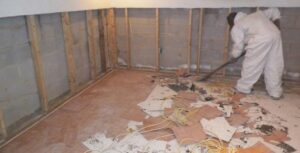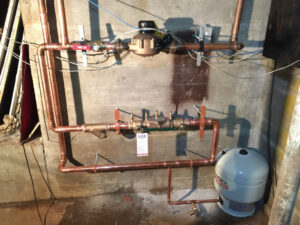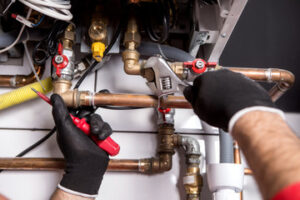Mold remediation is a complex process. It involves removing the mold, cleaning and drying the affected areas, and correcting the conditions that caused the mold to grow in the first place.

Before the remediation company arrives, homeowners should sequester house pets in a safe area, move cars away from the house, and clear out a wide access path to the mold area. Visit https://oneofakind.pro/ to learn more.
Mold is more than just a nuisance, it can be toxic and cause serious health issues. It can also damage surfaces and building materials. If the problem is severe, you may need to hire a specialist. These experts are trained to safely and effectively remove and clean mold growth and prevent future problems. They can also repair any damage that has been caused. They will also sanitize and disinfect the affected areas to help prevent the spread of mold spores.
The first step in the process is to identify the source of the mold. This can be difficult, as mold spores are often invisible to the naked eye. They can be found floating in the air, or growing on dark and damp surfaces. The spores need a food source to grow and thrive, and they are attracted to organic materials such as wood, paper, fabric and ceiling tiles.
Once the experts have identified the source of the mold, they can start to remove it. This will include removing any porous building materials such as drywall, carpeting and insulation. This is done using specialized equipment that protects the professionals from spreading spores throughout the home. It is important that all contaminated items are removed, as the spores can linger on other surfaces and in air ducts.
The experts will then clean and sanitize the area, using antimicrobial agents that kill mold spores and other microorganisms. This will be followed by a drying process, which involves misting the space with dehumidifiers. This will dry out the walls and other materials, and prevent further mold growth.
At this point, the restoration company will take a close look at any saveable contents, such as textiles, hard goods, electronics and photographs. They will be packed up and taken away for cleaning and restoration. This is a great way to save expensive belongings that could otherwise be lost to mold. They will also inspect the property for any other damage that needs to be repaired, such as leaks or foundation cracks. Moisture is the primary cause of mold, and identifying and fixing any sources of moisture will prevent future problems.
Removing the Mold
Molds can grow on just about anything if it has enough moisture, including drywall, wallpaper, carpet and fabric. They look like spots and can be a variety of colors, and they may smell musty. They also can be found behind walls, above ceilings and underneath flooring. Left untreated, mold growth can spread and damage your home’s structure, causing leaks and water damage as well as health problems.
To prevent this, you need to remove the mold, dry the area and fix any items that have been damaged. This process can take one to five days depending on the amount of mold, how long it has been there and where it is located in your home. Experts recommend that you take steps to protect yourself while working on the mold remediation. This includes wearing personal protective equipment (PPE) and putting plastic sheeting between the moldy area and the rest of your house.
After the mold is removed, you can start to clean your home. This includes washing hard surfaces with a detergent and bleach solution, and removing or cleaning fabrics that have been affected by the mold. You should also sanitize the entire area with a disinfectant. Then, you should dry the wet materials with fans and dehumidifiers to ensure that no moisture is leftover.
If you have any porous materials that have been affected by the mold, you must dispose of them. This includes drywall, plaster and upholstered furniture. Nonporous materials, such as glass and ceramics, can be cleaned.
Black mold grows in homes with leaking roofs, broken windows, damp basements and other areas of high humidity. It can cause a variety of health problems, such as difficulty breathing, fatigue, sneezing and nose bleeds. It can also cause a rare type of brain tumor.
Black mold can be difficult to remove because it is often hidden behind wallpaper and painted surfaces. In addition, it can grow very quickly. To help prevent black mold from spreading, you should clean it as soon as you notice any signs of it and fix the problem immediately.
Cleaning the Area
Mold is an annoying and dangerous problem that can occur in any building under the right conditions. All that it needs is moisture, warmth and organic material on which to grow, which can be provided by a natural disaster or by water damage caused by a broken pipe, for example. Once it takes hold, the fungus can quickly spread throughout the entire structure and cause severe property damage and health problems for anyone who breathes in the mold spores.
Fortunately, there are ways to prevent and stop mold growth before it starts. Getting rid of the source of the mold is one way to stop it from returning, and hiring a professional remediation company to help with the cleanup process is another. Remediation specialists know how to clean and sanitize the affected area without spreading mold spores, which is important for your health and the integrity of the home or business.
They may use a special disinfectant solution that is approved by the Environmental Protection Agency (EPA) to kill and remove the mold. This solution is generally sprayed on the surface of the mold and scrubbed with a brush, which can be very effective in removing the fungus. They are also trained to find and deal with hidden mold behind walls, in ceilings or under floors, and can usually restore the affected areas to their original condition.
Once the area is cleaned, it is important that it is contained to keep the spores from spreading to other parts of the house. Mold spores are microscopic and can ride the air currents until they come into contact with something that they can stick to, such as a person or animal breathing in the spores. This can lead to a variety of symptoms and reactions, including allergic reactions and asthma.
The remediation team will usually isolate the affected area with sheets of heavy plastic and duct tape, and will tape over heating or air conditioning vents in the room to prevent spores from being blown in other directions. They will also use negative air machines with high efficiency particulate air (HEPA) filters to keep spores, dust, microbial volatile organic compounds and other toxins from becoming airborne during the process. They will also dispose of any porous materials that have been in contact with the mold, such as drywall and carpeting.
Restoring the Area
When the mold has been fully removed and the affected area has been cleaned, it is important to prevent future growth. One of the best ways to do this is to fix the source of moisture. For example, if you have a water leak in your bathroom, it is important to get it fixed as soon as possible. Mold thrives in damp, dark areas, so if you can get the problem fixed quickly, it will be much harder for mold to grow in that area.
Another way to prevent mold is by keeping the area dry. This can be done by using fans and other tools to dry the area and by making sure that the humidity in the room is below a certain level. If the humidity is too high, mold spores will be able to grow and spread to other areas of your home or business.
It is also important to remove any items that have been damaged by the mold. These items should be placed in air-tight, thick plastic bags and disposed of properly. This step is particularly important for porous materials, such as drywall, which can be contaminated with toxic mold spores that are difficult to clean.
Before the mold remediation company arrives, it is a good idea to move as many of the items in the affected area as possible and to sequester house pets in a separate room or outside. It is also a good idea to clear a wide access path from the doorway of the affected area all the way to the dumpster. This will make it easier for the company to work in the area without spreading mold spores throughout the rest of your property.
The mold remediation process is a complicated one, but it can be very effective in eliminating harmful mold growth. If you notice any signs of mold, don’t hesitate to contact a professional mold remediation company for help. They will be able to identify the type of mold, contain it, and use a variety of methods to remove it from your property.

